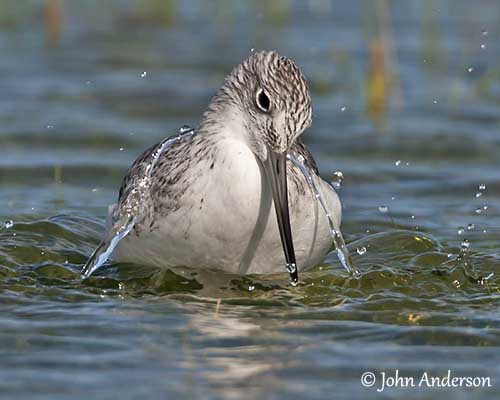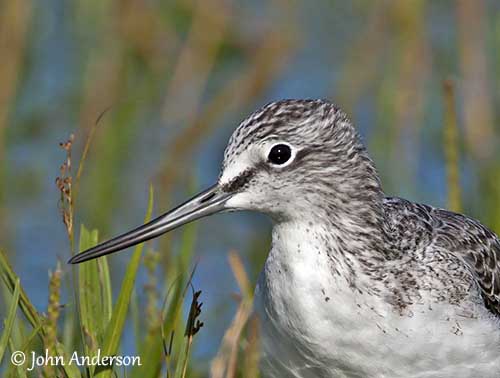
Fr: Chevalier aboyeur
Ang: Common Greenshank
All: Grünschenkel
Esp: Archibebe Claro
Ita: Pantana comune
Nd: Groenpootruiter
Sd: Gluttsnäppa
Photographers:
John Anderson
John Anderson Photo Galleries
José Luis Beamonte
Pájaros de España
Steve Garvie
RAINBIRDER Photo galleries & Flickr Rainbirder
Paul Guillet
Photos d’Oiseaux
Otto Plantema
Trips around the world
Nicole Bouglouan
PHOTOGRAPHIC RAMBLE
Text by Nicole Bouglouan
Sources:
HANDBOOK OF THE BIRDS OF THE WORLD Vol 3 by Josep del Hoyo-Andrew Elliott-Jordi Sargatal - Lynx Edicions - ISBN : 8487334202
SHOREBIRDS by Peter Hayman, John Marchant and Tony Prater – Christopher Helm – 1986 – ISBN: 0747014035
THE COMPLETE BOOK OF BRITISH BIRDS – Written by “Royal Society for the Protection of Birds” experts - Préface de Magnus Magnusson - Michael Cady- Rob Hume Editors - ISBN: 0749509112
GUIDE DES LIMICOLES de D. Taylor - Delachaux et Niestlé - ISBN : 2603014080
THE HANDBOOK OF BIRD IDENTIFICATION FOR EUROPE AND THE WESTERN PALEARCTIC by Mark Beaman, Steve Madge - C.Helm - ISBN: 0713639601
Greenshank: The Migration Story
Biodiversity Explorer – The Web of Life in Southern Africa
Pájaros de España (JL Beamonte)
Birds in backyards (Birds Australia and Australian Museum)
Sungei Buloh Wetlands Reserve (Michael Mastaller)
What Bird-The ultimate Bird Guide (Mitchell Waite)
Common Greenshank
Tringa nebularia
Charadriiformes Order – Scolopacidae Family
INTRODUCTION:
The Common Greenshank is an elegant wader, a common species in Europe and Asia where it frequents a variety of coastal and inland wetlands. It nests in taiga and forest areas of Palearctic. It is mostly migratory, and most Palearctic birds are trans Saharan migrants. They move S in broad front, often along the coasts but also inland.
The Common Greenshank has upcurved bill and long, greenish legs, two distinctive features of this species.

DESCRIPTION OF THE BIRD:
Biometrics:
Length: 30-35 cm
Wingspan: 68-70 cm
Weight: 125-290 g
The adult in breeding plumage has spotted and streaked black-brown upperparts, with browner lesser wing-coverts. In flight, the wings are dark and contrast with the white back, rump and uppertail-coverts. Longest uppertail-coverts and rectrices are barred dark brown.
The underparts are white with neck, upperbreast and flanks heavily streaked and spotted blackish-brown.
The head is streaked brown-black with whitish, streaked brown, crown and hindneck. We can see an indistinct whitish supercilium and a dark line extending from the lores to behind the eye. The head sides are whitish, streaked brown.
The long bill is slightly upcurved. The basal half is greenish-grey while the tip is blackish. The eyes are dark brown. Legs and feet are pale greyish-green or dull yellowish.
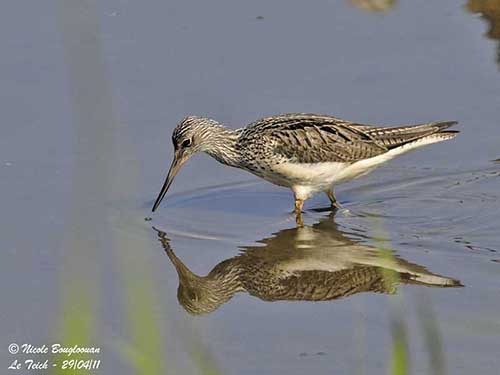
The female has similar plumage but she is slightly larger than male.
The non-breeding adult has the upperparts rather uniform grey. Breast, foreneck, face and underparts are white, contrasting with the dark wing-coverts.
The juvenile has browner upperparts with pale buff fringes than the non-breeding adult. Neck and breast can be more heavily streaked.
RANGE:
The Common Greenshank breeds in N Scotland and Scandinavia, E through C Asia to E Siberia and Kamchatka.
It winters from W Europe through Mediterranean to Africa, Madagascar, and E through Middle-East to S Asia, Indonesia and Australasia.
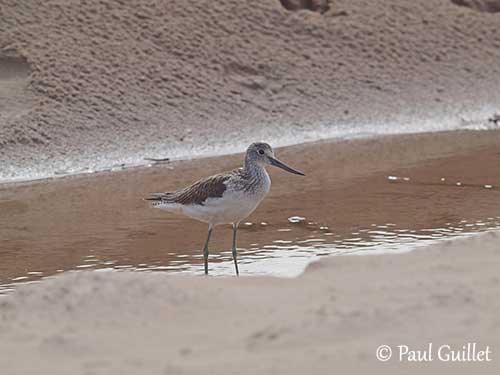
HABITAT:
The Common Greenshank breeds mainly in taiga zone, but also in forest clearings, moorlands with scattered trees, open bogs and marshes.
On migration, it can be seen inland in flooded meadows, marshes, sandbars and dried-up lakes.
It winters in a variety of wetlands, both marine and freshwater. It can be seen in estuaries, sandy or muddy riverbeds, rocky or sandy beaches, salt-marshes, lagoons and mangroves.
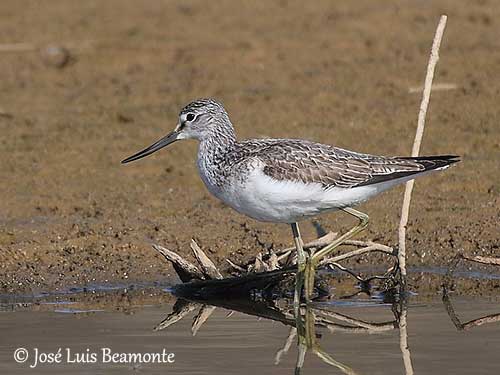
CALLS AND SONGS: SOUNDS BY XENO-CANTO
The Common Greenshank gives a loud, clear, trissylabic call, especially in flight and when flushed “tew tew tew”. The alarm call is a sharp “tchuk” or chip”.
During the breeding season, the sounds are more varied. The song is a melodious, repetitive “too-hoo-too-hoo…”
BEHAVIOUR IN THE WILD:
The Common Greenshank usually feeds alone, sometimes in flocks of 20-30 birds well spread-out. However, they gather into large flocks at roost, usually on open ground or on stumps at high tide.
It feeds in shallow water and at water’s edge. It walks steadily along the shoreline and often catches small fish by chasing it rapidly in the water. It may also run erratically through shallows to catch shrimps with the bill held slightly open.
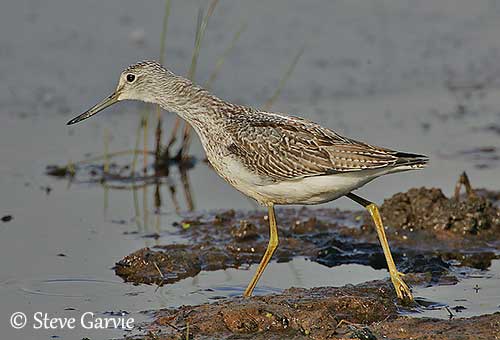
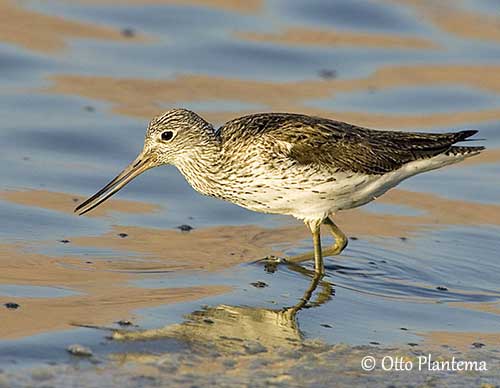
Its diet includes primarily insects and their larvae such as beetles, but it also takes aquatic invertebrates including crustaceans, annelids, molluscs, and also amphibians and small fish. Rodents are reported occasionally.
The Common Greenshank spends most of the time foraging with steady, elegant walk while pecking at the surface and probing with the long, upcurved bill.
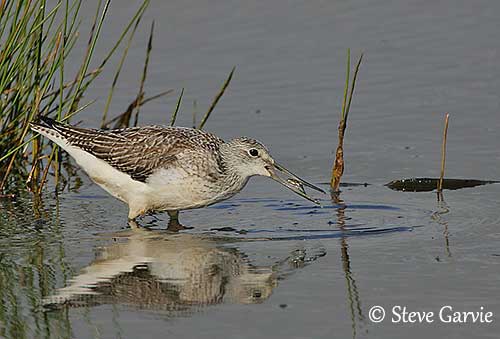
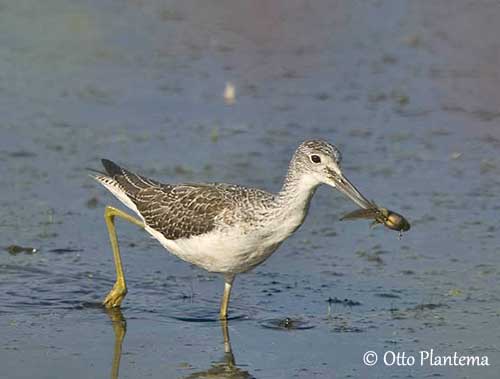
The Common Greenshank is monogamous, although some males are bigynous. The male arrives first at the breeding sites and establishes the territory. Then, it performs aerial displays. It rises up and down in the air while singing and sometimes tumbling and turning. These displays may occur at great height. The female mays sometimes join in the displays.
Several nests can be built by the male before the female selects one. Both parents share the nesting duties.
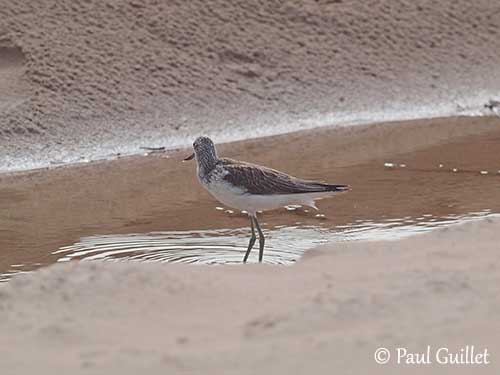
The Common Greenshank is migratory and moves S after the breeding season. Once arrived at their wintering grounds, they usually remain there with only some local movements. They arrive in South Africa and Australia in August/September.
They migrate over land in broad front, but numerous birds migrate through coastal sites. The Wadden Sea is often used as stopover by Fennoscandia’s birds, and also as moulting site. The spring migration is more direct and begins in March.
The Common Greenshank has swift, powerful flight with quick wingbeats and irregular turns.
REPRODUCTION OF THIS SPECIES:
The Common Greenshank breeds in spring with the laying from late April to June. They often return to the same breeding sites where densities are approximately 1,5-10 birds /kilometre.
The nest is a scrape on the ground, a shallow depression lined with grass and other plant material. It is usually placed next to a piece of dead wood.
The female lays 4 buffy-white eggs heavily spotted dark brown. Both adults incubate during 23-24 days. However, if the male has two mates, the female does most of the work.
At hatching, the chicks are pale grey with dark marking above and white underparts. They leave the nest very soon after hatching, and disperse away from the nest, hiding among the vegetation. One parent may leave quickly after the eggs hatch, and the other adult raises the young alone. But sometimes, the adults split up the chicks between them and the young are raised separately. They fledge between 25 and 30 days after hatching.
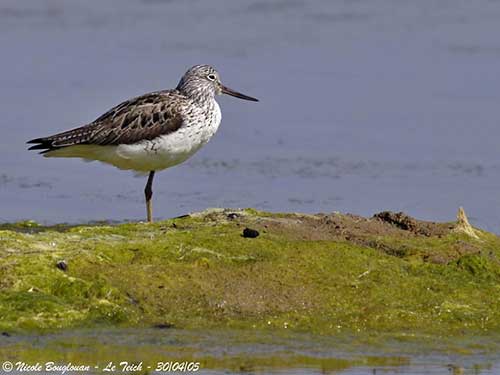
PROTECTION / THREATS / STATUS:
The Common Greenshank has wide range and the population is considered secure due to the extensive breeding range.
The global population is estimated to number 440,000/1,500,000 individuals (2006) and is suspected to be stable.
However, this species is threatened by degradation and habitat loss in Chinese North Korean and South Korean regions, due to pollution, reduced river flows and human disturbance.
But currently, the Common Greenshank is evaluated as Least Concern.
